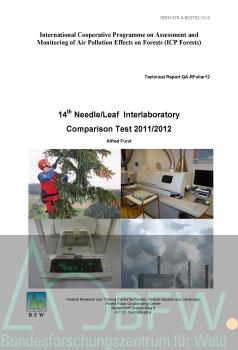- Standardsignatur15015
- Titel14th Needle/Leaf Interlaboratory Comparison Test 2011/2012
- Verfasser
- ErscheinungsortWien
- Verlag
- Erscheinungsjahr2012
- Seiten38 S. + Annex-Results
- MaterialMonographie
- ISBN978-3-902762-13-9
- Datensatznummer174530
- QuelleNeedle/Leaf Interlaboratory Comparison Test : Further Development and implementation of an EU-Level Forest Monitoring System - Futmon - : Technical Report LIFE+ QA-RFoliar10 in Cooperation with the International Cooperative Programme on Assessment and Monitoring of Air Pollution Effects on Forests (ICP Forests), 38 S. + Annex-Results
Technical Report QA-RFolia, 38 S. + Annex-Results - Abstract62 laboratories in 28 countries participated in the 14th Needle/Leaf Interlaboratory Test. A new system for qualification and re ]qualification started with the 11th test in 2009. This system was enlarged after the manual update in 2010 to all ICP ]Forests partners (see Konig et al. 2010, Rautio et al. 2010, Pitman et al. 2010). With the ring test report each participant received a qualification report. It has been decided to qualify the results of each parameter separately. If 50% or more (two, three or all four samples) of the results for this parameter for all the samples of the ring test are within the tolerable limits, the laboratory is qualified. Re ]qualification is mandatory for all ICP ]Forests laboratories, if monitoring results (foliage, litterfall, ground vegetation) will be submitted to PCC Hamburg in autumn 2012 from the vegetation period 2011. Also new in this test is the usage of maximum acceptable limits of quantification (LOQ). These limits are needed, because a lot of laboratories are using multi element methods (mostly ICP ]AES) with a high LOQ for some elements. But for evaluating and classification of the monitoring results lower LOQ are needed. A task was given from the 12th Expert Panel Meeting Foliage and Litterfall (Tallinn 2011) to the Working Group QA/QC in Laboratories to fix this problem. Maximum acceptable LOQ for mandatory and optional parameters for foliage, litterfall and ground vegetation were discussed and accepted in the 3rd Lab ]Head Meeting (Arcachon 2011). Because of this additional qualification parameter not so good results were expected especially for copper, lead and cadmium. Surprisingly, a high percentage of non tolerable results could be found for mandatory elements especially phosphorous (15.9%), calcium (14.7%), magnesium (19.3%) and potassium (21.0%). Most of these laboratories with QC/QA ]problems are using photometric methods for phosphorous determination and atomic absorption methods for calcium, magnesium and potassium determination. A clear recommendation to ICP ]AES can be given and, where ICP ]AES is not sensitive enough, ICP ]AES with ultrasonic nebulizer, ICP ]MS or Flameless AAS should be used. For nitrogen and carbon, element analyzers are the best choice, if a correct calibration is performed.
INTRODUCTION; TASK, MATERIAL, PARTICIPANTS, EVALUATION ; Task 3; Material ; Participants ; Data Evaluation ; RESULTS ; Main results of the questionnaire ; Results of the 14th Interlaboratory Comparison Test ; Comparison between the 14th Interlaboratory Test and former tests ; Evaluation by element ; Nitrogen ; Sulphur ; Phosphorus ; Calcium ; Magnesium ; Potassium ; Carbon ; Zinc ; Manganese ; Iron ; Copper ; Lead ; Cadmium ; Boron ; List of laboratories and responsible persons ; Method Code ‐ Pre‐treatment ; Method Code ‐ Determination ; List of abbreviations
- SchlagwörterNadelanalyse, Blattanalyse, Luftverschmutzung, Vergleichsanalyse, Vergleichsmethode, Monitoringprogramm, Labordaten, Laboruntersuchung, europäischer Vergleich, Erhebungsverfahren, Stickstoff, Schwefel, Phosphor, Calcium, Magnesium, Kalium, Zink, Mangan, Eisen, Kupfer, Blei, Cadmium, Bor, Kohlenstoff
- Klassifikation
| Exemplarnummer | Signatur | Leihkategorie | Filiale | Leihstatus |
|---|---|---|---|---|
| 1431486 | 15015 | Monographie | Büchermagazin | Verfügbar |

Hierarchie-Browser


